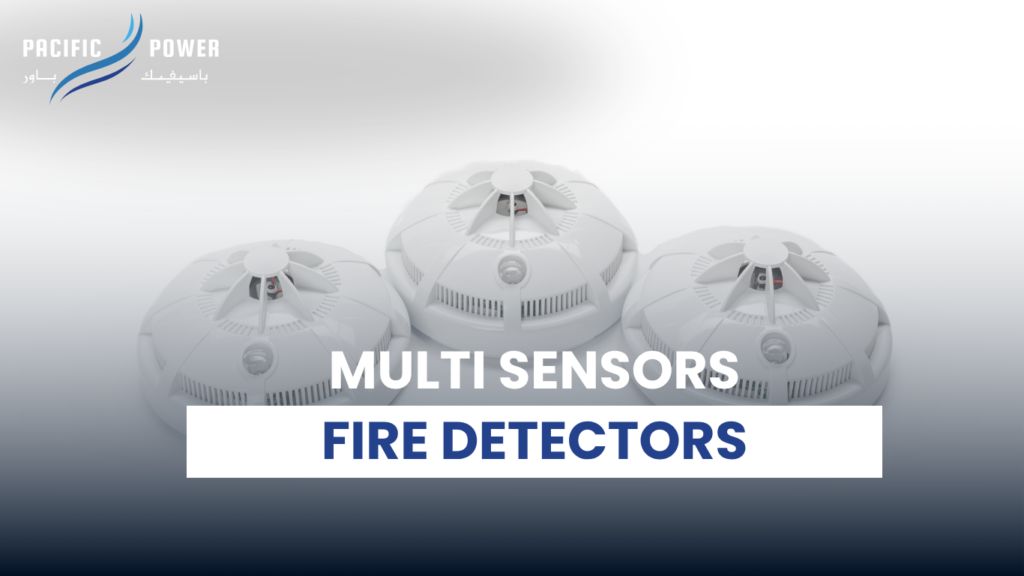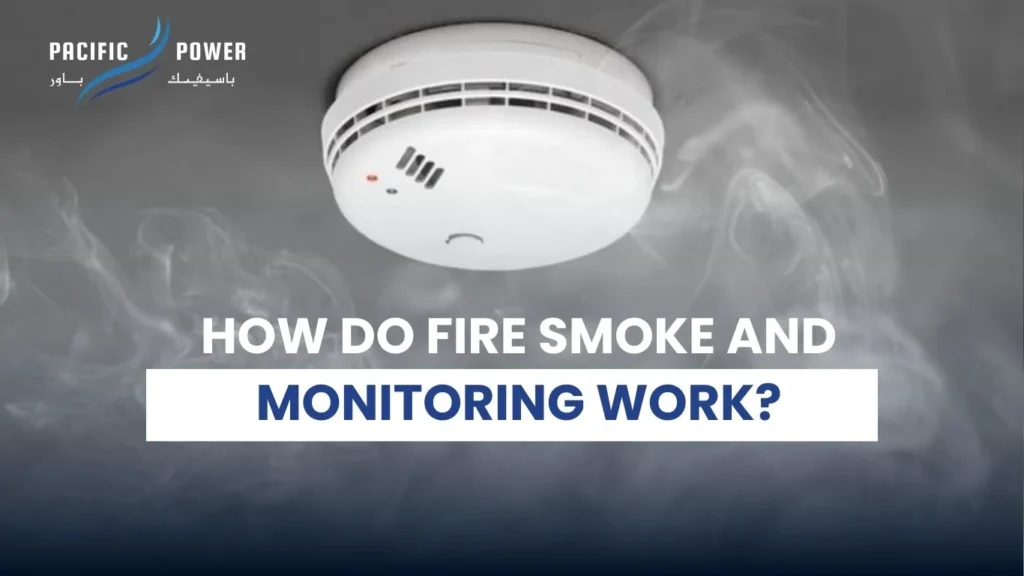
Table of Contents
Why Multi Sensor Fire Detectors Are Essential for Dubai Safety
Multi-sensor fire detectors have emerged as a critical solution, combining multiple detection technologies to enhance accuracy and comply with stringent UAE fire codes. These devices reduce false alarms and provide early warnings, safeguarding lives and property.
Lets explore the importance of multi-sensor fire detectors, their functionality, specific models, and their role in meeting UAE safety standards.
What are Multi-Sensor Fire Detectors?
Multi-sensor fire detectors integrate two or more detection technologies, such as optical, thermal, and carbon monoxide (CO) sensors. This is to identify fire signatures with greater precision than single-sensor devices.
Unlike traditional smoke or heat detectors, multi-sensor models like the Honeywell Notifier FAPT-851 or the Bosch FAP-440-DOTC analyze multiple fire indicators, reducing false alarms caused by environmental factors like dust or humidity, which are prevalent in the UAE’s arid climate. These detectors are designed to detect various fire types, from smoldering fires in residential settings to fast-flaming blazes in industrial complexes, ensuring comprehensive protection.
In the UAE, where diverse building types and high occupancy demand robust safety measures, multi-sensor detectors provide reliable early warnings. By cross-referencing data from multiple sensors, models like the Apollo Discovery Multi-Sensor Detector ensure faster response times, giving occupants more time to evacuate and enabling swift intervention by fire services.
Types of Multi-Sensor Detectors (As per UAE Fire Code)
The UAE Fire and Life Safety Code, enforced by authorities like Dubai Civil Defence, mandates that fire detection systems meet standards such as those set by the National Fire Protection Association (NFPA) and Underwriters Laboratories (UL). Multi-sensor detectors approved for UAE use include several types, with specific models tailored to various environments:
- Optical and Thermal Detectors: These combine smoke detection with heat sensors. The Honeywell Notifier FAPT-851, for example, uses optical sensors for smoke and thermal sensors for temperature spikes, ideal for residential and office spaces.
- Optical and CO Detectors: Models like the System Sensor 4WT-B integrate smoke and CO detection, crucial for fires producing high CO levels, such as those in enclosed spaces or involving synthetic materials.
- Triple-Sensor Detectors: The Bosch FAP-440-DOTC combines optical, thermal, and CO sensors, offering maximum reliability for high-risk areas like hotels, hospitals, and industrial facilities.
- Photoelectric and Ionization Combinations: While ionization sensors are less common due to environmental concerns, some detectors like the Apollo Discovery Multi-Sensor pair photoelectric and ionization technologies for enhanced detection of fast-burning fires.
Certified suppliers, such as Pacific Power UAE, ensure these models comply with UAE regulations, providing documentation for Civil Defence approvals.
How Do Multi-Sensor Detectors Work?
Multi-sensor fire detectors operate by analyzing data from multiple sensors to confirm fire presence, minimizing false alarms. For instance, the Apollo Discovery Multi-Sensor Detector uses the following components:
- Optical Sensors: These detect smoke particles by scattering light, effective for smoldering fires common in residential settings. The Honeywell Notifier FAPT-851 excels at identifying dense smoke.
- Thermal Sensors: These monitor rapid temperature rises or specific thresholds, as seen in the Bosch FAP-440-DOTC, which triggers alarms for flaming fires.
- CO Sensors: Found in models like the System Sensor 4WT-B, these detect carbon monoxide from incomplete combustion, critical for fires involving plastics or foam.
Intelligent algorithms in these detectors cross-reference sensor data.
For example, if the Apollo Discovery detects smoke but no significant temperature rise or CO, it may delay the alarm to avoid false triggers from steam or dust. This is particularly valuable in the UAE, where environmental factors like sandstorms or high humidity can mimic fire signatures.
Benefits of Multi-Sensor Technology
Multi-sensor fire detectors offer significant advantages, making them essential for UAE safety:
- Improved Accuracy: Models like the Bosch FAP-440-DOTC reduce false alarms by distinguishing between fire and non-fire triggers, such as cooking fumes or dust, common in the UAE’s climate.
- Faster Detection: The Honeywell Notifier FAPT-851 detects fires earlier by analyzing multiple signatures, enabling quicker evacuations.
- Versatility: These detectors handle diverse fire types, from smoldering fires in apartments to chemical fires in warehouses, as seen with the Apollo Discovery.
- Cost Savings: Reduced false alarms lower maintenance costs and prevent disruptions, making models like the System Sensor 4WT-B economical over time.
- Regulatory Compliance: All listed models meet UAE Fire Code standards, ensuring buildings pass inspections and secure insurance approvals.
These benefits make multi-sensor detectors a smart investment for Dubai property owners.
Installation and Compliance (As per UAE Fire Code)
Installing multi-sensor fire detectors in the UAE requires adherence to the UAE Fire and Life Safety Code. Key considerations include:
- Certified Installers: Only Civil Defence-approved contractors, like Pacific Power UAE, should install models like the Honeywell Notifier FAPT-851 to ensure compliance.
- Strategic Placement: Detectors must be placed in high-risk areas (e.g., kitchens, electrical rooms) per NFPA 72 standards, with models like the Bosch FAP-440-DOTC spaced for optimal coverage.
- System Integration: Detectors should connect to centralized fire alarm panels, as required for the Apollo Discovery Multi-Sensor Detector.
- Documentation: Installers must provide test reports and system design plans for Civil Defence approval, critical for occupancy permits.
Regular testing during installation ensures functionality, with non-compliance risking fines or delayed approvals.
Where Should Multi-Sensor Detectors Be Used?
Multi-sensor detectors are versatile and suited for various UAE environments:
- Residential Buildings: The System Sensor 4WT-B is ideal for apartments and villas, protecting bedrooms and kitchens from smoldering fires.
- Commercial Spaces: Offices and malls benefit from the Honeywell Notifier FAPT-851, which minimizes false alarms in high-traffic areas.
- Industrial Facilities: The Bosch FAP-440-DOTC is recommended for warehouses and factories with flammable materials.
- Healthcare and Hospitality: Hospitals and hotels use triple-sensor models like the Apollo Discovery for comprehensive protection.
- Educational Institutions: Schools rely on detectors like the System Sensor 4WT-B to safeguard classrooms and laboratories.
These models address the UAE’s diverse fire risks effectively.
Maintenance & Periodic Inspection Requirements
The UAE Fire Code mandates regular maintenance for multi-sensor detectors to ensure reliability:
- Annual Inspections: Certified technicians must test models like the Bosch FAP-440-DOTC annually to verify functionality and sensitivity.
- Cleaning and Calibration: Detectors like the Honeywell Notifier FAPT-851 require cleaning to remove dust, prevalent in the UAE, and recalibration for accuracy.
- Component Checks: Battery-powered models like the System Sensor 4WT-B need battery replacements, while hardwired systems require electrical checks.
- Record-Keeping: Maintenance logs for devices like the Apollo Discovery must be submitted during inspections to prove compliance.
Partnering with providers like Pacific Power UAE ensures adherence to these requirements, preventing system failures or regulatory issues.
Conclusion
Multi-sensor fire detectors, such as the Honeywell Notifier FAPT-851, Bosch FAP-440-DOTC, Apollo Discovery, and System Sensor 4WT-B, are vital for UAE fire safety. By integrating optical, thermal, and CO sensors, these devices offer unmatched accuracy, faster detection, and compliance with the UAE Fire and Life Safety Code. Their ability to reduce false alarms and handle diverse fire types makes them ideal for residential, commercial, and industrial settings. For property owners, investing in these advanced detectors and partnering with certified providers ensures safety, regulatory compliance, and peace of mind in the UAE’s dynamic environment.

